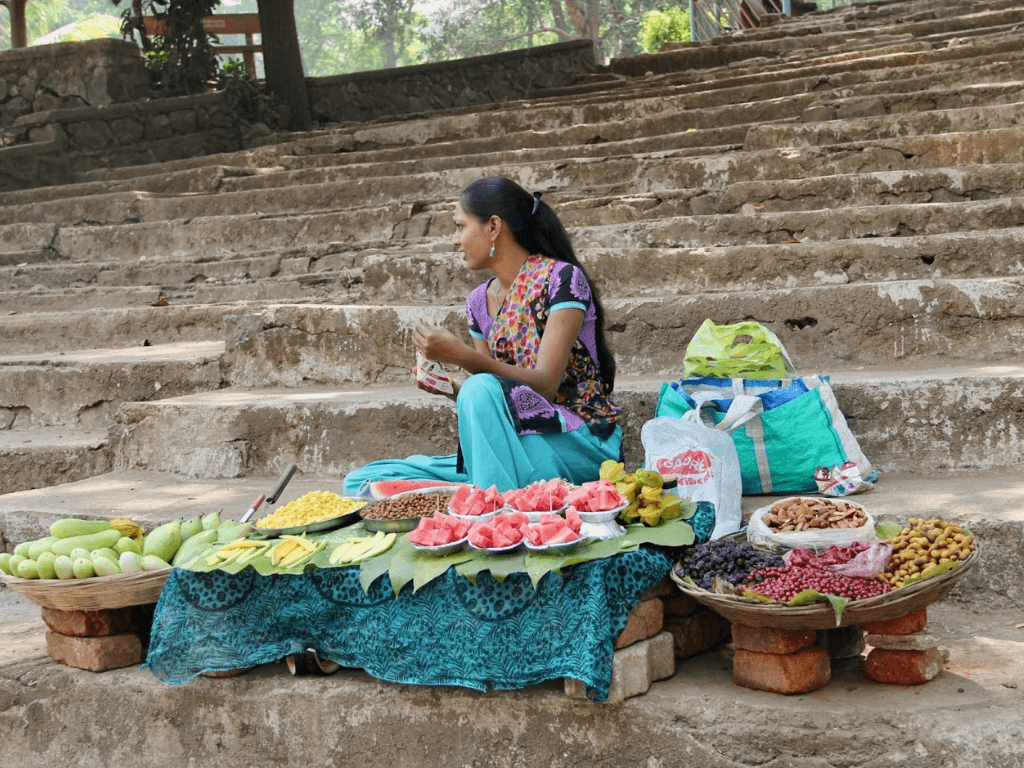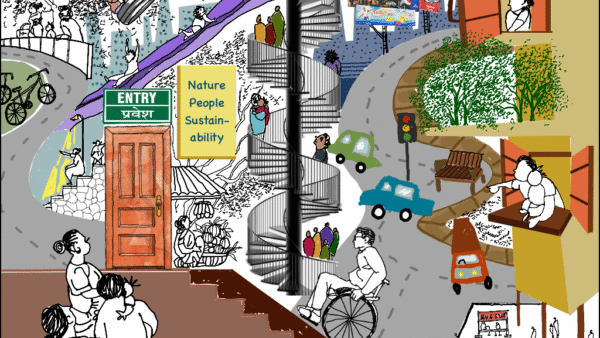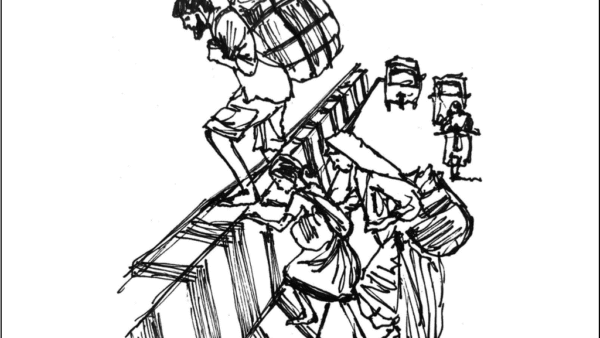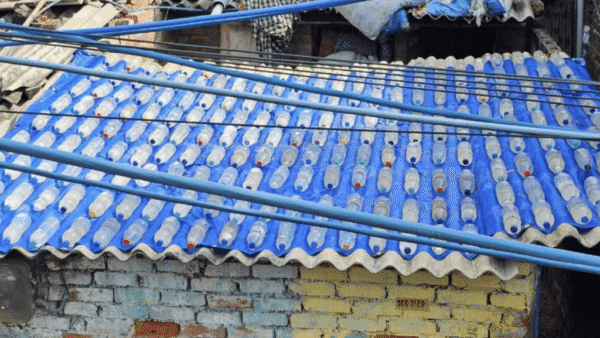The 106-square kilometre Sanjay Gandhi National Park,[1] flanked by Mumbai and Thane cities, nurtures a different kind of life within its expanse, one that has tribals coexisting with leopards, dense foliage, and the rhythms of the seasons. For generations, the Adivasi communities living across the park’s approximately 43 padas, or settlements,[2] have called this forest their home, the only one they know. Their continued living is threatened not by the wild but by the city planning to expand its footprint.
Somewhere along the way, slum tenements came up in the outer edges or buffer zone, perhaps were allowed to; so also lavish bungalows amidst the Yeoor hills. Any plan for the park should have done away with all these to restore the natural habitat. Instead, the draft zonal master plan for the eco-sensitive zone – essentially the buffer zone – makes the future uncertain for the Adivasis. Already, the upcoming infrastructure projects in and around the park –- the Coastal Road extension till Palghar, the 14-lane road through Ghodbunder, and the Goregaon-Mulund Link Road tunnel – have disrupted their lives. Opening the eco-sensitive zone to more construction such as resorts, lodges, and weekend homes may worsen the disruption.
However, displacement has long shadows in this forest. In the mid-1990s, after a Bombay High Court order called for the removal of encroachments to protect its core and buffer zone, about 15,000 families were rehabilitated in Mumbai’s Chandivali. Others evicted were relocated to Palghar and Dahanu, only for many to return when they found no work there. Each return was officially met with suspicion, repeated threats of displacement, and the label of ‘encroacher’. The Adivasis and the slum dwellers are entirely different communities with differing ties to the forest but, officially, they are often lumped together which the former detest.
For them, daily life is a negotiation at multiple levels. For example, electricity supply is absent or patchy in the padas. When a young boy was electrocuted while tapping into a supply, the authorities cut power to his home. Families to depend on oil lamps or tenuous connections from staff quarters, and coerced into paying their bills in return. “Do we not have basic rights because we are Adivasis?” asks Shamubai Barap, a resident of Navapada. Adds Dinesh Barap: “First they gain our trust, then they snatch away our livelihoods. The idea is to make us helpless so they can change who lives here.”
The demography of the padas has gradually changed. The Forest Department and the National Park authorities employ workers from outside who settle down in the padas – and eventually stand by the authorities to counter local resistance. Here are some voices of the Adivasis, speaking of its changing rhythms and the threats that shadow their lives.
Dinesh Barap, Navapada, 31
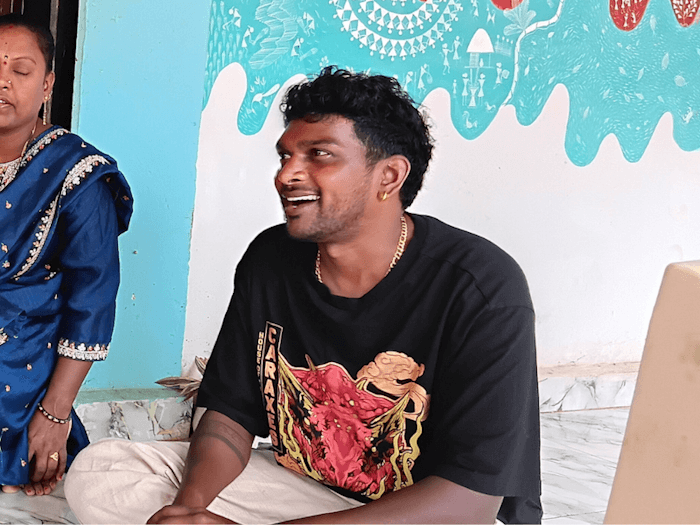
The air in Navapada is alive with sounds of children’s chatter, chirping birds and the rhythm of forest life that fills the silences between conversations. Seated on the verandah of his house, Dinesh Barap, an acclaimed Warli artist (Warli art is one of India’s oldest tribal arts created by the Warli tribe), and a graduate in History and Marathi from Ruia College, who has lived here, speaks about his experiences.
“I am among the few from my community to have studied and worked beyond the forest. When I travelled by Mumbai’s local train for the first time, I fell down. I met teachers and friends who taught me about Mumbai – its pace, its people, its layers. I had once dreamt of joining the Sir JJ School of Art but life took another turn. My father was diagnosed with cancer. We spent months in and out of the Tata Memorial Hospital and Nair Hospital. It changed everything. Two weeks ago, I finally enrolled in Sir JJ School for a Master’s degree in portrait and ceramic art. Often, a part of me wonders how someone like me studied so much but I recall the encouraging words of those who support me.”
“Like many inside SGNP, I had only heard about the draft master plan from activists. No one here was told anything officially. The plan will change things in the forest. I’ve seen many places where termite hills and other hills have been destroyed to construct roads. This will continue in the name of eco-tourism. The natural paths are changing. There used to be an easy co-existence between the forest and us. Like our relationship with the elephant that once lived here – everyone fed him chapattis and jaggery, he would bathe in the river, and the children would sit on him. On the day of my sister’s wedding, he crossed the mandap like a daughter leaving home and was taken away by the Forest Department saying he was ‘wild’ and a threat to us. He was not. The whole village cried.”
“The demographic of the pada is slowly changing. People who were brought to the park to work are now in greater numbers. They support politicians, not us. They were brought to work as van mazdoors (forest labourers) but they eventually secured permanent jobs earning Rs 40,000 to Rs 50,000 a month, and got government housing. Some get their houses by being friendly with forest guards. These jobs are not given to Adivasis. Now there are van buggies – forest vehicles — but the women workers are not from the padas. Only work like removal of fallen trees, putting out fires, and cleaning is done by Adivasis; some also work as domestic help in the bungalows around here.”
“As an artist, my duty is to tell stories of the forest and its people. My work Forest in the City,[3] captures fragments of local memory – the creation of the Tulsi Lake, rituals by pujaris before the construction of a dam, the fisherwoman Tulsi after whom the lake was named in the British era. Other stories also find their way into my sketches – a woman who built a separate room to protect a termite hill, and called lizards, bats and peacocks her family; Manglabhai, whose hundred sheep were seized by the Forest Department and his mother went with an activist to Mantralaya to bring them back; and a tradition of Kamdadi dance before cooking Fodshi ki sabzi (koli bhaji). People ask if I don’t want to move to the city and make a name after art education. But I am connected to the forest, my culture is rooted here. If the forest and animals exist, so will we. Otherwise, it’s all over.”
Shamubai Suresh Barap, Navapada, 51
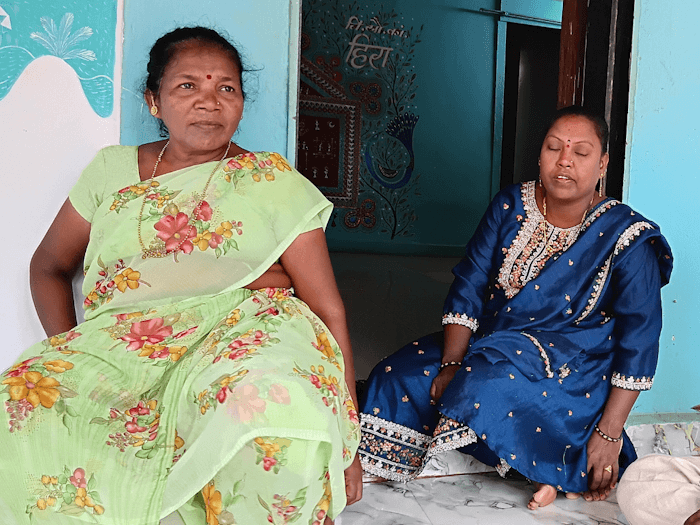
When we meet Shamubai Suresh Barap (left), she is interrupted by a bike-borne man asking for help. The Forest Department is threatening to seal his house after he and his friends drove a four-wheeler into a restricted area. They want Shamubai to intervene. Mediating with officials is a role she’s used to playing; people call her when there’s a dispute. Shamubai is among the strongest voices here, advocating for children’s education and health, often walking to ten neighbouring padas to counsel women on the importance of sending children to school and the need for access to medical facilities. She is fondly known as the ‘Savitribai’ of her pada.
“Once, I was beaten and stripped by men for advocating for education in the village. That didn’t stop me though. I arrived in Navapada when I was around 12 years old, after marrying into the Barap family and moving from Nalasapora. Back then, people foraged for dry wood. We made our houses and settled in the forest and, later, turned to farming as a source of livelihood. We paid dhara and taxes to the BMC for the land; we had cows, goats, and sheep. Back then, only a few were educated and there were no documents or proofs to show ownership or residence.”
“Our homes were woven with dried kosam and karvy stems, and the floors smeared with mud and cow dung. The bricks were handmade. Our house was renovated only four years ago but the new tin-sheet roof, forced by the Forest Department some 4-6 years ago, traps heat. Earlier, we used dried karvy stems with mud smeared on top — they kept the house cool and were harmless to the forest. Now if we collect them, we are arrested. I think trees should grow naturally instead of having plantation drives which are done for projects that caused deforestation.”
“We don’t litter. We know how to live with the forest. Jungle tithe ahmi – where the jungle is, we are. We have protected the forest and it has protected us. I remember when the National Park was smaller; land was acquired in phases. The Kisan Nagar Upvan and Tungareshwar ranges are now under SGNP. Forest nantar aala ahe (we were earlier, forest came later). Over time, our cattle were trapped and taken away. The authorities cut off trails and wild animals have nowhere to go. Where herds of deer used to be, you see only one-two now. From my window, I can still spot leopards. My pet ducks are descendants of a female Mexican duck once brought to the park for taxidermy.”
Vandana Tokre, Keltapada, in her 40s
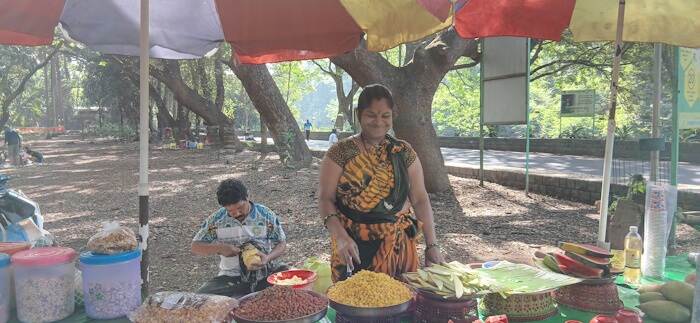
Vandana Tokre sits by the roadside with a basket of fruit — starfruit, watermelon, guava. She deftly slices a guava, sprinkles salt and chilli powder, and mixes chana with onions and tomatoes for us as she speaks. Like many Adivasi women in this hamlet in the SGNP, she sells fruit and nimbu pani (lime water) throughout the day or boiled corn when it’s in season.
“I came here after getting married. I moved here from Naigaon near the Western Express Highway. We are a four-member household with electricity, cooking gas, and piped water; no one can remove us. People say that we in the padas will get evicted, they are evicting us to save the jungle, it seems. The notices and warnings have been coming since the 1995 High Court judgment. Nothing is in our hands now. Shamubai Barap’s house is where people from neighbouring padas gather for meetings and discussions. I join them sometimes. We are unsure what to prepare for, where we might be sent. We have been demanding that we get a house inside the forest itself. This is a question of our livelihood. Once we leave the main gates, no one will let us enter again.”
“I have seen what happened to Malapada and Talapada – both padas were evicted for the underground Borivali Thane Tunnel Road. Habalepada was saved during the construction of the Goregaon-Mulund Link Road but the Film City has swallowed large parts of SGNP. The film people dump their POP sets in the forest itself. Unlike earlier, people no longer cut or forage for dry wood. Now, everyone has a gas pipeline at home; only a few go deep into the forest to pluck wild vegetables. We eat what we grow. It’s fresh, clean and without any pesticides.”
Ramesh Vansha Valvi, Patonapada, 45
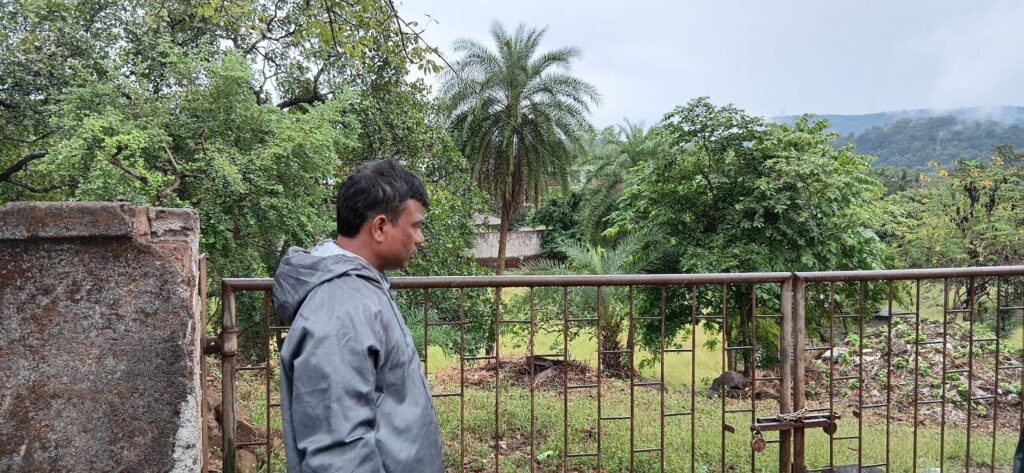
Ramesh Vansha Valvi, is the fourth generation of his family living in Yeoor on the Thane side of the SGNP. A farmland owner and one of the village leaders, he is a part of the recently formed Forest Rights Committee. He has watched the forest change dramatically through the years.
“Natural streams originating from the forest are destroyed and contaminated by all the resorts and hotels who throw their waste and let out their wastewater into them. I remember, as a child, drinking from those streams and catching fish. Now, we cannot hear the crickets or the frogs in this water anymore. The trees used to be full of fireflies; now I don’t even spot one. The destruction that’s already happening is being legalised through the draft zonal master plan.”
“The Bhendi Nala, the main stream connecting to smaller ones before draining into the Chena river, is now polluted and lifeless. The cycle between nature and Adivasis is destroyed. It told us when it was going to rain and when we should plant crops. At night, instead of the sound of insects, there are laser lights and blaring music from wedding venues. We don’t see owls or bats which were so commonly seen before. Vultures used to sit in huge numbers on the taadi trees. As children, we would come especially to see them. The taadi fruits used to fall to the ground by sheer weight. We had a relationship with all this. We don’t have photos of that time because no one anticipated we would reach this stage.”
Nikeita Saraf, a Thane-based architect and urban practitioner, works as illustrator and writer with Question of Cities. Through her academic years at School of Environment and Architecture, and later as Urban Fellow at the Indian Institute of Human Settlements (IIHS), she tried to explore, in various forms, the web of relationships which create space and form the essence of storytelling. Her interests in storytelling and narrative mapping stem from how people map their worlds and she explores this through her everyday practice of illustrating and archiving.
Cover photo: Savitha Suri
Other photos: Nikeita Saraf

